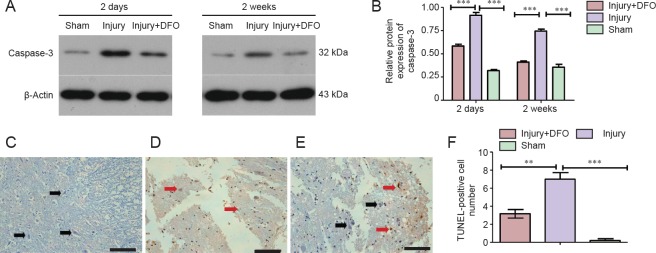Figure 7.
DFO effects on cell apoptosis in the injured spinal cord of rats.
(A, B) Caspase-3 levels are markedly increased in the injury group 2 days and 2 weeks post injury. DFO treatment (Injury + DFO) reduces the caspase-3 protein expression level compared with that in saline-treated injured spinal cord. Band intensity analysis reveals a significant difference between the injured saline- and DFO-treated rats (***P < 0.001 for the comparisons indicated). (C–F) The TUNEL assay results reveal neurons with normal morphology (black arrows) that are not positive for TUNEL in the sham group. However, 2 days post spinal cord injury, the number of TUNEL-positive cells (red arrows) increases markedly in the injury group (D) (***P < 0.001), whereas the number of TUNEL-positive cells is lower in the injury + DFO group (E). Scale bars: 100 μm. (F) Statistical analysis reveals that the DFO-treated rats have a significantly lower number of TUNEL-positive cells than the saline-treated injured rats 2 days post injury (**P < 0.01; mean ± SEM, n = 3 per group, one-way analysis of variance followed by Tukey's post hoc test). TUNEL: Terminal deoxynucleotidyl transferase dUTP nick endlabeling; DFO: deferoxamine. Deferoxamine.

